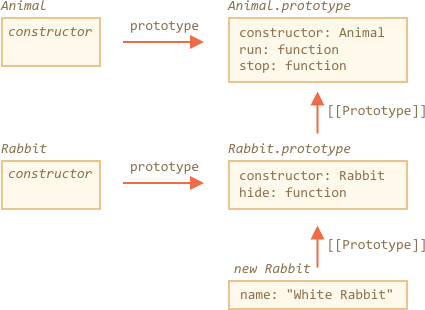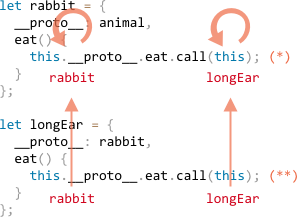12 KiB
Class inheritance
Let's say we have two classes.
Animal:
class Animal {
constructor(name) {
this.speed = 0;
this.name = name;
}
run(speed) {
this.speed += speed;
alert(`${this.name} runs with speed ${this.speed}.`);
}
stop() {
this.speed = 0;
alert(`${this.name} stopped.`);
}
}
let animal = new Animal("My animal");
...And Rabbit:
class Rabbit {
constructor(name) {
this.name = name;
}
hide() {
alert(`${this.name} hides!`);
}
}
let rabbit = new Rabbit("My rabbit");
Right now they are fully independent.
But we'd want Rabbit to extend Animal. In other words, rabbits should be based on animals, have access to methods of Animal and extend them with its own methods.
To inherit from another class, we should specify "extends" and the parent class before the brackets {..}.
Here Rabbit inherits from Animal:
class Animal {
constructor(name) {
this.speed = 0;
this.name = name;
}
run(speed) {
this.speed += speed;
alert(`${this.name} runs with speed ${this.speed}.`);
}
stop() {
this.speed = 0;
alert(`${this.name} stopped.`);
}
}
*!*
// Inherit from Animal
class Rabbit extends Animal {
hide() {
alert(`${this.name} hides!`);
}
}
*/!*
let rabbit = new Rabbit("White Rabbit");
rabbit.run(5); // White Rabbit runs with speed 5.
rabbit.hide(); // White Rabbit hides!
Now the Rabbit code became a bit shorter, as it uses Animal constructor by default, and it also can run, as animals do.
Internally, extends keyword adds [[Prototype]] reference from Rabbit.prototype to Animal.prototype:
So, if a method is not found in Rabbit.prototype, JavaScript takes it from Animal.prototype.
As we can recall from the chapter info:native-prototypes, JavaScript uses the same prototypal inheritance for build-in objects. E.g. Date.prototype.[[Prototype]] is Object.prototype, so dates have generic object methods.
````smart header="Any expression is allowed after extends"
Class syntax allows to specify not just a class, but any expression after extends.
For instance, a function call that generates the parent class:
function f(phrase) {
return class {
sayHi() { alert(phrase) }
}
}
*!*
class User extends f("Hello") {}
*/!*
new User().sayHi(); // Hello
Here class User inherits from the result of f("Hello").
That may be useful for advanced programming patterns when we use functions to generate classes depending on many conditions and can inherit from them.
## Overriding a method
Now let's move forward and override a method. As of now, `Rabbit` inherits the `stop` method that sets `this.speed = 0` from `Animal`.
If we specify our own `stop` in `Rabbit`, then it will be used instead:
```js
class Rabbit extends Animal {
stop() {
// ...this will be used for rabbit.stop()
}
}
```
...But usually we don't want to totally replace a parent method, but rather to build on top of it, tweak or extend its functionality. We do something in our method, but call the parent method before/after it or in the process.
Classes provide `"super"` keyword for that.
- `super.method(...)` to call a parent method.
- `super(...)` to call a parent constructor (inside our constructor only).
For instance, let our rabbit autohide when stopped:
```js run
class Animal {
constructor(name) {
this.speed = 0;
this.name = name;
}
run(speed) {
this.speed += speed;
alert(`${this.name} runs with speed ${this.speed}.`);
}
stop() {
this.speed = 0;
alert(`${this.name} stopped.`);
}
}
class Rabbit extends Animal {
hide() {
alert(`${this.name} hides!`);
}
*!*
stop() {
super.stop(); // call parent stop
this.hide(); // and then hide
}
*/!*
}
let rabbit = new Rabbit("White Rabbit");
rabbit.run(5); // White Rabbit runs with speed 5.
rabbit.stop(); // White Rabbit stopped. White rabbit hides!
```
Now `Rabbit` has the `stop` method that calls the parent `super.stop()` in the process.
````smart header="Arrow functions have no `super`"
As was mentioned in the chapter <info:arrow-functions>, arrow functions do not have `super`.
If accessed, it's taken from the outer function. For instance:
```js
class Rabbit extends Animal {
stop() {
setTimeout(() => super.stop(), 1000); // call parent stop after 1sec
}
}
```
The `super` in the arrow function is the same as in `stop()`, so it works as intended. If we specified a "regular" function here, there would be an error:
```js
// Unexpected super
setTimeout(function() { super.stop() }, 1000);
```
Overriding constructor
With constructors it gets a little bit tricky.
Till now, Rabbit did not have its own constructor.
According to the specification, if a class extends another class and has no constructor, then the following constructor is generated:
class Rabbit extends Animal {
// generated for extending classes without own constructors
*!*
constructor(...args) {
super(...args);
}
*/!*
}
As we can see, it basically calls the parent constructor passing it all the arguments. That happens if we don't write a constructor of our own.
Now let's add a custom constructor to Rabbit. It will specify the earLength in addition to name:
class Animal {
constructor(name) {
this.speed = 0;
this.name = name;
}
// ...
}
class Rabbit extends Animal {
*!*
constructor(name, earLength) {
this.speed = 0;
this.name = name;
this.earLength = earLength;
}
*/!*
// ...
}
*!*
// Doesn't work!
let rabbit = new Rabbit("White Rabbit", 10); // Error: this is not defined.
*/!*
Whoops! We've got an error. Now we can't create rabbits. What went wrong?
The short answer is: constructors in inheriting classes must call super(...), and (!) do it before using this.
...But why? What's going on here? Indeed, the requirement seems strange.
Of course, there's an explanation. Let's get into details, so you'd really understand what's going on.
In JavaScript, there's a distinction between a "constructor function of an inheriting class" and all others. In an inheriting class, the corresponding constructor function is labelled with a special internal property [[ConstructorKind]]:"derived".
The difference is:
- When a normal constructor runs, it creates an empty object as
thisand continues with it. - But when a derived constructor runs, it doesn't do it. It expects the parent constructor to do this job.
So if we're making a constructor of our own, then we must call super, because otherwise the object with this reference to it won't be created. And we'll get an error.
For Rabbit to work, we need to call super() before using this, like here:
class Animal {
constructor(name) {
this.speed = 0;
this.name = name;
}
// ...
}
class Rabbit extends Animal {
constructor(name, earLength) {
*!*
super(name);
*/!*
this.earLength = earLength;
}
// ...
}
*!*
// now fine
let rabbit = new Rabbit("White Rabbit", 10);
alert(rabbit.name); // White Rabbit
alert(rabbit.earLength); // 10
*/!*
Super: internals, HomeObject
Let's get a little deeper under the hood of super. We'll see some interesting things by the way.
First to say, from all that we've learned till now, it's impossible for super to work.
Yeah, indeed, let's ask ourselves, how it could technically work? When an object method runs, it gets the current object as this. If we call super.method() then, how to retrieve the method? Naturally, we need to take the method from the prototype of the current object. How, technically, we (or a JavaScript engine) can do it?
Maybe we can get the method from [[Prototype]] of this, as this.__proto__.method? Unfortunately, that doesn't work.
Let's try to do it. Without classes, using plain objects for the sake of simplicity.
Here, rabbit.eat() should call animal.eat() method of the parent object:
let animal = {
name: "Animal",
eat() {
alert(`${this.name} eats.`);
}
};
let rabbit = {
__proto__: animal,
name: "Rabbit",
eat() {
*!*
// that's how super.eat() could presumably work
this.__proto__.eat.call(this); // (*)
*/!*
}
};
rabbit.eat(); // Rabbit eats.
At the line (*) we take eat from the prototype (animal) and call it in the context of the current object. Please note that .call(this) is important here, because a simple this.__proto__.eat() would execute parent eat in the context of the prototype, not the current object.
And in the code above it actually works as intended: we have the correct alert.
Now let's add one more object to the chain. We'll see how things break:
let animal = {
name: "Animal",
eat() {
alert(`${this.name} eats.`);
}
};
let rabbit = {
__proto__: animal,
eat() {
// ...bounce around rabbit-style and call parent (animal) method
this.__proto__.eat.call(this); // (*)
}
};
let longEar = {
__proto__: rabbit,
eat() {
// ...do something with long ears and call parent (rabbit) method
this.__proto__.eat.call(this); // (**)
}
};
*!*
longEar.eat(); // Error: Maximum call stack size exceeded
*/!*
The code doesn't work anymore! We can see the error trying to call longEar.eat().
It may be not that obvious, but if we trace longEar.eat() call, then we can see why. In both lines (*) and (**) the value of this is the current object (longEar). That's essential: all object methods get the current object as this, not a prototype or something.
So, in both lines (*) and (**) the value of this.__proto__ is exactly the same: rabbit. They both call rabbit.eat without going up the chain in the endless loop.
Here's the picture of what happens:
-
Inside
longEar.eat(), the line(**)callsrabbit.eatproviding it withthis=longEar.// inside longEar.eat() we have this = longEar this.__proto__.eat.call(this) // (**) // becomes longEar.__proto__.eat.call(this) // that is rabbit.eat.call(this); -
Then in the line
(*)ofrabbit.eat, we'd like to pass the call even higher in the chain, butthis=longEar, sothis.__proto__.eatis againrabbit.eat!// inside rabbit.eat() we also have this = longEar this.__proto__.eat.call(this) // (*) // becomes longEar.__proto__.eat.call(this) // or (again) rabbit.eat.call(this); -
...So
rabbit.eatcalls itself in the endless loop, because it can't ascend any further.
The problem can't be solved by using this alone.
[[HomeObject]]
To provide the solution, JavaScript adds one more special internal property for functions: [[HomeObject]].
When a function is specified as a class or object method, its [[HomeObject]] property becomes that object.
This actually violates the idea of "unbound" functions, because methods remember their objects. And [[HomeObject]] can't be changed, so this bound is forever. So that's a very important change in the language.
But this change is safe. [[HomeObject]] is used only for calling parent methods in super, to resolve the prototype. So it doesn't break compatibility.
Let's see how it works for super -- again, using plain objects:
let animal = {
name: "Animal",
eat() { // [[HomeObject]] == animal
alert(`${this.name} eats.`);
}
};
let rabbit = {
__proto__: animal,
name: "Rabbit",
eat() { // [[HomeObject]] == rabbit
super.eat();
}
};
let longEar = {
__proto__: rabbit,
name: "Long Ear",
eat() { // [[HomeObject]] == longEar
super.eat();
}
};
*!*
longEar.eat(); // Long Ear eats.
*/!*
Every method remembers its object in the internal [[HomeObject]] property. Then super uses it to resolve the parent prototype.
[[HomeObject]] is defined for methods defined both in classes and in plain objects. But for objects, methods must be specified exactly the given way: as method(), not as "method: function()".
In the example below a non-method syntax is used for comparison. [[HomeObject]] property is not set and the inheritance doesn't work:
let animal = {
eat: function() { // should be the short syntax: eat() {...}
// ...
}
};
let rabbit = {
__proto__: animal,
eat: function() {
super.eat();
}
};
*!*
rabbit.eat(); // Error calling super (because there's no [[HomeObject]])
*/!*



